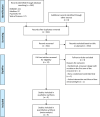Blue-Light Therapy for Seasonal and Non-Seasonal Depression: A Systematic Review and Meta-Analysis of Randomized Controlled Trials
- PMID: 35522196
- PMCID: PMC9511000
- DOI: 10.1177/07067437221097903
Blue-Light Therapy for Seasonal and Non-Seasonal Depression: A Systematic Review and Meta-Analysis of Randomized Controlled Trials
Abstract
Objectives: To determine the efficacy and safety of blue-light therapy in seasonal and non-seasonal major depressive disorder (MDD), by comparison to active and inactive control conditions.
Methods: We searched Web of Science, EMBASE, Medline, PsycInfo, and Clinicaltrials.gov through January 17, 2022, for randomized controlled trials (RCTs) using search terms for blue/blue-enhanced, light therapy, and depression/seasonal affective disorder. Two independent reviewers extracted data. The primary outcome was the difference in endpoint scores on the Structured Interview Guide for the Hamilton Depression Rating Scale - Seasonal Affective Disorder (SIGH-SAD) or the Structured Interview Guide for the Hamilton Depression Rating Scale with Atypical Depression Supplement (SIGH-ADS) between blue light and comparison conditions. Secondary outcomes were response (≥ 50% improvement from baseline to endpoint on a depression scale) and remission rates (endpoint score in the remission range).
Results: Of 582 articles retrieved, we included nine RCTs (n = 347 participants) assessing blue-light therapy. Seven studies had participants with seasonal MDD and two studies included participants with non-seasonal MDD. Four studies compared blue light to an inactive light condition (efficacy studies), and five studies compared it to an active condition (comparison studies). For the primary outcome, a meta-analysis with random-effects models found no evidence for the efficacy of blue-light conditions compared to inactive conditions (mean difference [MD] = 2.43; 95% confidence interval [CI], -1.28 to 6.14, P = 0.20); however, blue-light also showed no differences compared to active conditions (MD = -0.11; 95% CI, -2.38 to 2.16, P = 0.93). There were no significant differences in response and remission rates between blue-light conditions and inactive or active light conditions. Blue-light therapy was overall well-tolerated.
Conclusions: The efficacy of blue-light therapy in the treatment of seasonal and non-seasonal MDD remains unproven. Future trials should be of longer duration, include larger sample sizes, and attempt to better standardize the parameters of light therapy.
Keywords: blue-light therapy; major depressive disorder; non-seasonal depression; seasonal affective disorder; seasonal depression; wavelength.
Conflict of interest statement
Figures



References
-
- Lam RW, Levitt AJ, Levitan RD, et al. Efficacy of bright light treatment, fluoxetine, and the combination in patients with nonseasonal major depressive disorder: a randomized clinical trial. JAMA Psychiatry. 2016;73(1):56-63. - PubMed
-
- Martensson B, Pettersson A, Berglund L, Ekselius L. Bright white light therapy in depression: a critical review of the evidence. J Affect Disord. 2015;182:1-7. - PubMed
-
- Tao L, Jiang R, Zhang K, et al. Light therapy in non-seasonal depression: an update meta-analysis. Psychiatry Res. 2020;291:113247. - PubMed
Publication types
MeSH terms
LinkOut - more resources
Full Text Sources
Medical

